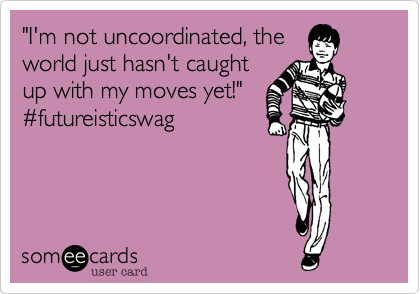What exactly is the carpal tunnel?
The carpal tunnel is a tunnel created by your wrist bones (carpals) and the flexor retinaculum (a fibrous band of tissue that keeps your flexor tendons in place). It’s actually fairly large. Large enough that in cadaver lab you can put your index finger through it.
What goes through the carpal tunnel?
Nine tendons. The tendons are for the muscles that allow you to curl your fingers or to make a fist (flexor tendons). And, the median nerve…
Read MoreWhen I was still in school an older doc gave me some good advice. “Learn the shoulder, because everyone you treat will have a shoulder problem. It doesn’t matter if they come in for back pain, knee pain, hip pain, headaches...they will also have a shoulder problem.” Turns out she was right!
Why are shoulder issues so prevalent? A lot of it has to do with…
Read MoreThe idea of composting has always creeped me out. As a general rule I try to keep my contact with rotting food to a minimum.
All of that changed, however, at a community composting class.
When the instructor passed around a ziploc container of a dark rich substance with the color and texture of coffee grounds, I fell in love. That stuff looked rich and nourishing and so...non-gross. Was it really possible to turn kitchen scraps and yard waste into that?
The instructor then discussed…
Don't have hundreds of dollars to spend on a standing desk?
That's ok.
A lot of the benefits of standing can also be achieved with kneeling. Kneeling wakes up your stabilizer muscles, prevents your psoas and hip flexors from being in a chronically shortened position, and keeps your glutes active.
And, it's cheap!
Just shove that crappy desk chair aside, put down a cushion, and…
What is the greatest predictor of injury?
Previous injury.
Tissue and bone actually heal quite rapidly. But why does that area keep getting re-injured? Because there is a difference between healing, and achieving full function.
Your rotator cuff surgery was 5 years ago, so why is that area still hurting? Why does your back seem fine for a couple of years, and then all of a sudden flare up again?
Because you may have not restored full function to that area.
When we are injured, the brain does a great job of avoiding use of that area. During the healing stage this is beneficial. But when those patterns of avoidance continue after the tissue has healed, it can create…
Read MoreNOTE: CLASS SOLD OUT. To find out about future classes please like our Facebook page.
Falling apart and don't know where to start?
Start at the beginning! Using developmental patterns we will learn how to Breathe - Stabilize - Move.
Have you ever started an exercise program, only to keep injuring yourself?
Do you workout, but feel like your core just isn't engaging like it should be?
Do you have constant neck and back tension?
Are your hamstrings and calves always tight?
Do you feel uncoordinated or disconnected from your body?
As babies we are all born with the same developmental patterns. First we learn to breathe and stabilize our core. Then we learn to roll to our side, brace on our elbows, crawl, stand and walk.
Starting from a safe position on the ground, we will…
Read MoreYour Hips Don't Hinge
As in the earlier example of the mid back (see Part 2), if motion is lacking somewhere else (mid back, hips) your low back has to take up the slack.
As part of the initial assessment and functional movement screen, I test every new patient on their "hip hinge". Even if they don’t have back pain, I want to make sure they are moving properly so that they aren’t putting stress on their low back. Fixing this one movement can be life-changing for a patient in pain, and highly preventative for folks that have poor movement patterns. If someone has a limited hip hinge…
Read MoreYour core is uncoordinated
Notice I didn’t say “weak”? Just uncoordinated.
First, what is the core? Many folks picture six-pack abs as the illustration of a perfect core. Nope.
The core consists of four muscle groups: pelvic floor, diaphragm, transverse abdominus, and multifidi.
In order for the core to properly stabilize you, all of these muscles must work together as a unit. You can’t just train one part of the core and…
Read MoreYou have a lazy butt / sleepy ass
Check out your glutes. They look impressive don’t they? After all, the gluteus maximus is the largest muscle in your body.
But, those glutes may be all show, and no go.
In a perfect world, your glutes initiate hip extension (moving your leg behind your body).
But what happens when the glutes are out to lunch? The next extensors in the chain, your low back paraspinals, have to do the work.
No one likes to do a lot of extra work, and…
Read MoreAs a chiropractor, I’m sure you would think my number one answer would be “it needs an adjustment”. Not necessarily. In fact, in many cases the low back hurts because it is moving too much. In this series I’ll walk you through five reasons your low back might be hurting.
Note: the reasons are in no particular order, and you may have more than one reason involved in your particular case.
Reason One: Your upper back isn’t moving enough.
Your body consists of alternating areas of mobility and stability. The ankle…
Read MoreInterview: Jerry Husted at Adaptability Fitness
Where are you located and how long have you been in business?
Adaptability Fitness has been in operation since November 2013. We’re located at 585 Osuna Rd NE, Albuquerque, NM 87113; directly north of Sandia Preparatory School.
What inspired you to become a trainer?
After a bad back injury, I gained a tremendous amount of weight and an addiction to pain medication. When I decided to take my life back, I started reading. Books, magazines, internet were the resources available to me and I was stunned and aggravated by…
Read More










